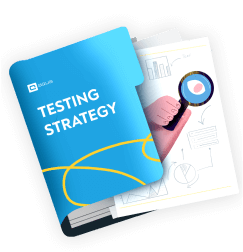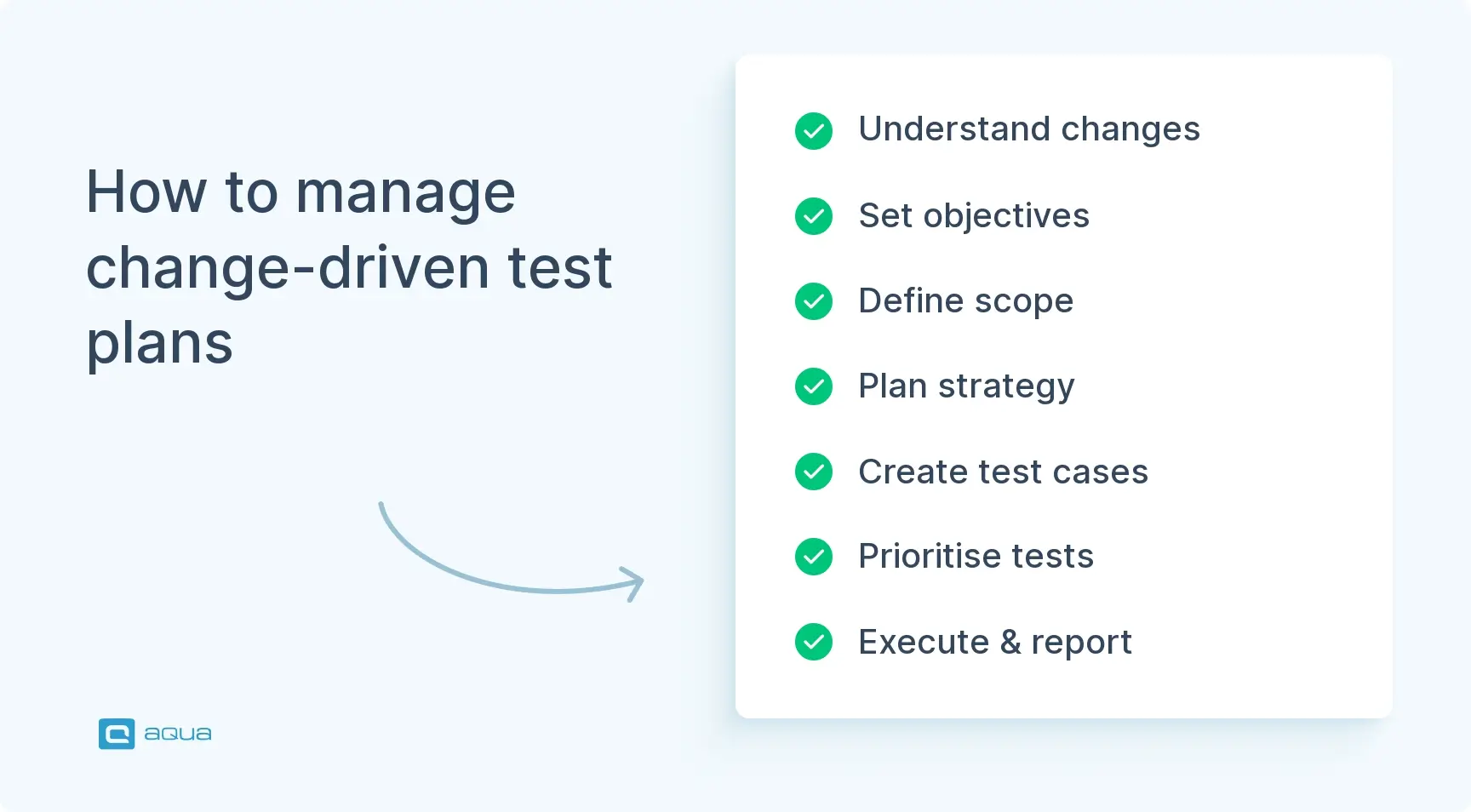Whether you’re a testing pro or just starting, this article will help you understand how to make testing plans work well. So, let’s dive in and uncover the tips for mastering test plan management to keep your projects sailing smoothly through development challenges.
What is test plan management?
Test plan management is the systematic approach of creating, organising, implementing, and tracking test plans in software development. A test plan outlines the details and strategy for executing tests on a software product to ensure its quality, functionality, and reliability.
You need test plans that actually work when chaos hits your project timeline. Smart test plan management means setting crystal-clear entry/exit gates upfront, like “no testing starts until 80% of APIs are stable” or “we ship when critical path scenarios pass three consecutive runs.”
You need to build in assumption checkpoints every two weeks. When requirements inevitably shift, you’re not scrambling to rewrite everything from scratch. Using this approach, you will see nearly half last-minute testing crunches.
Pick three non-negotiable success metrics and one “project pivot” trigger that automatically flags when your plan needs updating.
Essential components of a test plan
There are several components of the test management plan, including these:
- Planning involves defining the scope of testing, objectives, testing strategies, resources required, and timelines. It’s like charting the course before setting sail.
- Documentation ensures everyone understands the testing objectives, test cases, and methodologies. Clear documentation maintains consistency and clarity throughout testing.
- Resource allocation involves assigning tasks and responsibilities to team members with the right skills and approach.
- Execution is where the actual testing occurs, and the test cases outlined in the test plan are executed. Any defects found during testing are documented for further analysis.
- Monitoring and reporting the testing progress is crucial to identify potential roadblocks and ensure the project stays on track. Regular reports help to communicate the status of testing to stakeholders.
- Adaptation is needed if issues arise during testing or if requirements change. This flexibility ensures testing remains aligned with the evolving needs of the project.
- Closure is the final component of test plan management, coming after successful testing. This involves analysing the results, addressing outstanding issues, and finalising the testing documentation.

How to create and manage test plans for different projects?
Test planning and management in software testing for diverse projects require a structured approach for each project’s unique characteristics. It begins by comprehensively understanding project goals and requirements through collaboration with stakeholders. Defining testing types, such as functional, performance, or security testing, provides a roadmap for the testing process. Identifying the scope of testing, including the tested features and components, ensures focus and efficiency. You’ll want to nail down your test cases first, then rank them by what could actually break your users’ experience. Focus on areas where code changed recently; that’s where bugs love to hide.
Assign one person as the testing owner for each feature. No shared responsibility means no finger-pointing later. Map your testing windows to release dates, but throw in buffer time because something always goes sideways.
Start with the “happy path” scenarios that cover 80% of user actions. Your riskiest test cases aren’t always the complex ones. Sometimes it’s the simple login flow that crashes during peak traffic. The test execution is followed by continuous monitoring, reporting, and adapting the test plan based on changing project dynamics. Regular communication with stakeholders is crucial to ensure that the test plan remains aligned with evolving project requirements.
You can unlock the potential of your testing efforts with aqua’s testing strategy template — your ultimate guide to mastering testing intricacies. Whether you’re a seasoned QA professional or a testing enthusiast, this comprehensive resource equips you with proven methodologies and expert insights. Tailor your testing approach to different projects, refine your techniques, and ensure the highest quality outcomes. With aqua’s testing strategy template, you’ll confidently navigate the testing complexities.

Do not miss out on the transformative QA guide you need
Updating and Maintaining Your Test Plan
Your test plan shouldn’t sit in some forgotten folder collecting digital dust. Think of it more like a living document that breathes with your project. When requirements shift (and they will), when new features pop up, or when timelines get squeezed, that’s when you need to revisit and refresh your plan.
Update your test plan after every sprint retrospective, whenever scope changes hit, or when major bugs throw your testing strategy off track. Focus on tweaking the big stuff first, your in-scope and out-of-scope items, resource allocation, key milestones, and those entry/exit criteria that keep everyone honest.
Set up version tracking in your test management tool. This simple move keeps your team on the same page and creates a clear trail of how your testing approach evolved.
Remember: your test plan should grow alongside your project, not get written once and forgotten. The most successful QA teams treat their plans like code: constantly refined, regularly updated, and always improving.
How to create a test plan for a set of changes/user stories/product updates?
It is one thing to create a software test plan for a new project, but how do you respond to a set of changes, user stories, or a product update? Well, you need a focused and streamlined process, including these:
1. Understand the changes:
- Begin by thoroughly understanding the changes, user stories, or product updates that must be tested.
- Review the documentation, requirements, and any associated design specifications.
2. Identify testing objectives:
- Define the specific testing objectives for the changes. Are you testing new features, bug fixes, performance enhancements, or a combination?
- Ensure that your testing objectives align with the project’s overall goals.
3. Define the scope:
- Clearly define the scope of testing.
- List the user stories, features, or components of the changes.
- Determine whether these changes will impact any existing functionality needing to be retested.
4. Create a testing strategy:
- Decide on the testing approach. Will you perform manual testing, automated testing, or a combination of both?
- Consider the criticality of the changes and the most suitable testing methods.
5. Create test cases:
- Develop detailed test cases based on user stories or changes.
- Write test cases that cover different scenarios, edge cases, and workflows related to the changes.
6. Prioritise test cases:
- Prioritise the test cases based on the impact and importance of the changes.
- Focus on testing critical functionalities first to ensure they work as expected.
7. Specify the testing environment:
- Determine the testing environments required to validate the changes.
- Ensure that the necessary hardware, software, browsers, and devices or emulation options are available for testing.
8. Allocate resources:
- Assign team members to specific testing tasks based on their expertise and availability.
- Allocate resources such as devices, tools, and testing environments as needed.
9. Execute tests:
- Execute the defined test cases in the designated testing environment.
- Document the results, including any defects or unexpected behaviours.
10. Conduct regression testing:
- Perform regression testing to ensure the changes do not adversely affect existing functionalities.
- Reuse or modify existing test cases as needed for regression testing.
11. Report and communicate:
- Generate regular test progress reports to keep stakeholders informed.
- Communicate any significant findings, issues, or concerns to the relevant parties.
12. Acceptance testing:
- Once testing is completed and the changes meet the defined criteria, conduct acceptance testing with stakeholders or users.
13. Documentation:
- Document the test plan, test cases, results, and lessons learned.
- This documentation serves as a reference for future releases and helps maintain consistency.
14. Review and closure:
- Review the test results and confirm the changes meet the desired quality standards.
- Address and resolve any outstanding issues before finalising the test plan.

Best tools for test plan management
Regarding test planning and management, having the right tools can significantly impact your testing strategies and overall efficiency. Some notable options:
- Qase offers simplicity but lacks advanced features and an On-Premise option, which may limit its scalability and customisation for complex test plan management needs.
- Xray is primarily a Jira plugin, which may not be the ideal standalone solution for test plan management. Additionally, its future availability for On-Premise users may be a concern as of 2024.
- TestLodge, while user-friendly, may need more advanced test plan management capabilities, such as AI-driven automation and comprehensive traceability.
- TestCollab is a decent choice for smaller teams but may lack scalability and robust reporting features for large-scale test plan management.
- TestLink is open-source and budget-friendly but may require more manual effort for test plan management, lacking some of the automation features found in more advanced tools.
While these tools have their merits and shortcomings, there is a perfect test planning and management solution for you, called aqua cloud.
aqua cloud: Elevating Test Planning and Management
aqua cloud sets itself apart by offering comprehensive Test Management System (TMS) and Application Lifecycle Management (ALM) functionalities, covering all your test plan management requirements. Its modern and innovative AI capabilities revolutionise the testing process, simplifying and accelerating work exponentially. Here are some key highlights of what aqua can accomplish:
- Requirements management: Seamlessly work with and efficiently manage requirements within the aqua ecosystem.
- Change tracking: Keep a close eye on changes in test items, requirements, or defects, ensuring traceability throughout the project.
- Test coverage visualisation: Visualise test coverage to gain insights into testing progress and identify areas that require attention.
- Lifecycle tracing: Trace the complete lifecycle of a test, requirement, or defect, enabling a holistic view of your project’s progress.
- Advanced test structuring: Use nested test steps and shared test cases for improved test case organisation.
- Multi-environment compatibility: Work effortlessly with multiple testing environments, accommodating various testing scenarios.
- Robust integrations: Connect with various external integrations, from Jira synchronisation to managing automated testing frameworks.
- KPI-based monitoring: Monitor real-time KPI-based dashboards and create custom reports tailored to your needs.
Using AI and Automation in Test Plan Management
Test plan management is getting a serious upgrade thanks to AI, and the results speak for themselves. Tools like aqua cloud are rolling out features that can auto-generate test cases straight from your requirements, smartly prioritise tests based on recent code changes, and use AI to speed up defect analysis by nearly 60%.
Let AI handle your routine test case creation for new features. You’ll quickly see how it catches edge cases that manual planning often misses. The real-time dashboards throw in progress tracking and coverage metrics without the usual reporting headache.
Do all these, and your next sprint planning just got a whole lot smoother.
Conclusion
The art of managing test plans is not merely a task but a strategic endeavour that bridges the gap between creativity and precision. From understanding project nuances to crafting meticulous test cases, from coordinating resources to adapting in the face of change – every facet of this process contributes to the quality assurance process that resonates with excellence.
It is time to say goodbye to manual test plan chaos and welcome streamlined efficiency with aqua. Our modern QA testing software harnesses AI’s power to revolutionise how you manage test plans. Seamlessly tailor your test strategies to diverse projects while enjoying real-time insights, lifecycle tracing, change tracking, effective monitoring, and effortless collaboration. With aqua, you’re not just managing tests but piloting a modern airliner. Experience the convenience and precision of aqua’s automation and AI-driven features, allowing you to set the course and enjoy the flight while aqua handles the rest of the control for you.
Experience the future of test plan management – explore aqua cloud today


















